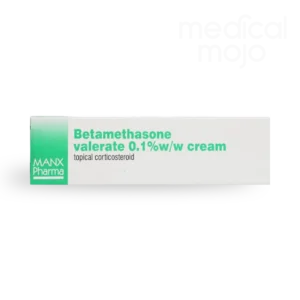Betnovate is a potent topical steroid cream, ointment, and lotion that treats various skin conditions. It is a prescription-only medicine, POM, that is only available on prescription. So, what can Betnovate treat? It is widely used to ease skin inflammation, swelling, and itching associated with common skin issues.
Let’s dive into how Betnovate works, what conditions it treats, and how to use it safely. You can use the navigational table below to skip to topics that interest you directly.
-
 Betamethasone 0.1% Cream£7.99 – £21.99
Betamethasone 0.1% Cream£7.99 – £21.99 -
 Betamethasone 0.1% Ointment£7.99 – £21.99
Betamethasone 0.1% Ointment£7.99 – £21.99 -
 Betnovate Scalp Application£15.99 – £38.97
Betnovate Scalp Application£15.99 – £38.97
What is Betnovate?
Betnovate is a prescription topical steroid that helps manage inflammation symptoms like redness, itching, and swelling (NHS, 2024). It contains betamethasone valerate, a powerful corticosteroid that soothes irritation by reducing the body’s natural inflammatory response in the skin. Topical corticosteroids, like
Betnovate plays a massive role in treating many skin conditions, especially inflammatory conditions such as eczema and irritant dermatitis (Gabros et al., 2018).
What causes inflammatory skin rashes?
When allergens or irritants trigger inflammation, they release certain chemicals that cause the skin to become red, itchy, and swollen. Betnovate helps to control these reactions, calming the skin and reducing symptoms.
Inflammatory skin conditions like eczema and dermatitis are often triggered by a combination of genetic, immune, and environmental factors. These conditions occur when the immune response in the skin becomes overactive, leading to inflammation, redness, and itching (Weidinger & Novak, 2016).
Eczema, or atopic dermatitis, is associated with a weakened skin barrier, allowing irritants and allergens to penetrate the skin more easily, provoking an immune response (Bieber, 2008). This immune response releases inflammatory molecules, such as cytokines, which cause the characteristic symptoms.
How does Betnovate work?
Betnovate’s active ingredient, betamethasone valerate, is a corticosteroid that slows down the body’s inflammatory response. It basically tells the body’s immune system to calm down. Betnovate helps reduce swelling, itching, and redness in affected areas. When applied directly to the skin, Betnovate quickly eases symptoms, allowing the skin to heal.
Topical corticosteroids like betamethasone (Betnovate) bind to glucocorticoid receptors in skin cells, lowering the production of inflammatory molecules and locally suppressing the immune response (Liu et al., 2013).
This helps to reduce swelling, itching, and redness, providing symptomatic relief. Betamethasone is a high-potency corticosteroid, often prescribed for short-term use to minimise risks such as skin thinning, which can occur with extended use (Ference & Last, 2009).
What conditions can Betnovate treat?
Betnovate is often prescribed to treat various skin conditions, including:
- Allergic Contact Dermatitis – skin reaction from contact with allergens
- Atopic Eczema – chronic itchy and inflamed skin
- Discoid Lupus Erythematosus (DLE) – a chronic skin condition related to lupus
- Irritant Contact Dermatitis – skin inflammation from contact with irritating substances
- Lichen Planus – a condition causing purple, itchy skin bumps
- Neurodermatitis (e.g., Lichen Simplex) – chronic itching and scratching
- Prurigo Nodularis – itchy nodules that develop on the skin
- Psoriasis – an autoimmune condition that causes red, scaly patches
- Seborrhoeic Dermatitis – a chronic form of eczema that affects oily areas like the scalp
- Insect Bites and Stings – severe reactions to bites and stings that cause inflammation and itching
Which form of Betnovate should you use?
Betnovate comes in several formulations designed for different skin areas:
The “vehicle” is the substance that carries the medication. Choosing the right vehicle depends on the area of the skin and the type of skin condition. It also helps keep the skin hydrated and boosts medication absorption (Lee et al., 1999).
Betnovate comes in several formulations designed for different skin areas:
- Ointments: These are best for thick, rough skin patches (hyperkeratotic lesions). They are the most potent because they trap moisture well, but they should be avoided on areas with hair since they can clog follicles, leading to folliculitis. Ointments are They are also better for dry, scaly areas like elbows and knees.
- Creams: They are less powerful than ointments but are more skin-friendly, leaving no residue. Due to their drying, non-occlusive effect, creams are ideal for areas with moist inflammation or in skin folds (like armpits).
- Lotions: Light and non-greasy, making them a good choice for hairy areas.
- Gels: Similar to lotions, gels are light and non-greasy, ideal for scalp use as they don’t cause hair to stick together.
- Foams: Great for applying steroids to the scalp, although they tend to be more expensive.
Each type is chosen based on the skin area and type of skin issue, as well as how much hydration and absorption are needed.
Betnovate scalp solution
Apply Betnovate scalp solution directly to the affected skin once or twice daily, following your doctor’s instructions. Once symptoms begin to improve, you can reduce the frequency of use. Here are some important safety guidelines:
- Avoid sensitive areas – do not apply Betnovate to the face or broken skin unless directed by a doctor.
- Avoid contact with eyes – if Betnovate gets into your eyes, nose, or mouth, rinse thoroughly with cold water.
- Avoid flames – Betnovate lotion is flammable; keep away from open flames or heat sources.
- Don’t use on infected skin – unless prescribed for an infection, avoid applying Betnovate to infected areas.
- Children – Betnovate is not recommended for children under one-year-old.
If your symptoms haven’t improved after two weeks or if your skin condition worsens, contact your doctor for further guidance.
How much Betnovate to apply?
When you get instructions to apply a thin layer, what exactly does this mean? How much do you apply? This could lead some people to apply too much while others do not apply enough. Applying large quantities of potent steroids, like Betnovate, can cause serious side effects (Gabros et al., 2018); this is why it is so important to apply the correct amount.
The Fingertip Unit, or FTU, was created to address this issue. The FTU is basically the amount of cream that covers the fingertip. This ensures that the correct amount of potent steroids, like Betnovate, is applied.
Adverse effects of Betnovate
Local effects on skin (common with prolonged use):
- Skin Atrophy (thinning): Thinning skin from long-term use; presents with redness, visible blood vessels, and easy bruising. Reversible over time once steroid use stops (Coondoo et al., 2014).
- Striae (Stretch Marks): Develop from skin damage and stress; appear as permanent scars.
- Acne: Can develop from clogged follicles and bacterial growth due to steroid use.
- Steroid Rosacea: Erythema (redness) and pustules triggered by repeated steroid use.
- Perioral Dermatitis: Red pustules around the mouth (not on lips) from potent steroids on the face.
- Other Rare Effects: Excess hair growth, changes in skin colour, and slower wound healing.
Systemic effects (rare due to low skin absorption):
These side effects are mainly seen when people take oral corticosteroids, such as prednisolone, for a prolonged period of time (Liu et al., 2013). This is why it is so important to use the correct amount of Betnovate to prevent inadvertent overdosing. See the above section on how to apply Betnovate.
Each side effect varies in severity and may depend on the dosage and duration of corticosteroid use.
- Bone Issues: Osteoporosis and fractures can happen even at low doses due to bone weakening.
- Adrenal Suppression: Long-term use can suppress natural cortisol production, making it difficult for the body to handle stress.
- Cushingoid Features: Side effects include fat redistribution (like “moon face” and “buffalo hump”), weight gain, and truncal obesity.
- Diabetes and High Blood Sugar: Increases blood sugar levels, which may cause or worsen diabetes, especially after meals.
- Muscle Weakness: Causes weakness in large muscles over weeks or months; usually reversible when stopped.
- Eye Conditions: Higher doses can lead to glaucoma (high eye pressure) and cataracts (clouded vision).
- Mental Health Changes: May cause mood swings, anxiety, insomnia, and even psychosis at high doses over time.
- Increased Infection Risk: Suppresses immune response, making users more prone to infections, especially fungal and viral.
- Heart Health Issues: Linked to hypertension, weight gain, and increased risk of heart problems.
- Digestive Issues: Can lead to stomach irritation, ulcers, and discomfort, particularly when combined with NSAIDs.
- Growth Suppression (in Children): It can stunt growth and delay puberty in children and teens, sometimes leading to reduced adult height.
Contraindications: who should not take Betnovate?
- Infections: Avoid using on bacterial infections (e.g., impetigo, cellulitis) as steroids can mask infection symptoms.
- Fungal Infections: Use cautiously on fungal infections like candida; risk of worsening or spreading (tinea incognito).
Can Betnovate be used with other medications?
If you are on other medications or using additional topical treatments, let your doctor know before using Betnovate. When using multiple topical treatments, space out applications to allow each product to be fully absorbed.
If you’re also using moisturisers, apply them at least 30 minutes before Betnovate to avoid diluting the medication.
Final thoughts on Betnovate
Betnovate is an effective treatment for various inflammatory skin conditions when used as directed. Reducing inflammation, itching, and swelling helps the skin heal while preventing further irritation. Always follow your doctor’s instructions for safe use and reach out if you have questions or if symptoms persist.
Where to buy Betnovate?
- Betnovate cream 30g from £7.99
- Betnovate ointment 30g from £7.99
- Betnovate scalp application 100ml from £15.99
Disclaimer: This article is for informational purposes only and does not replace professional medical advice.
References:
- https://www.nhs.uk/medicines/betamethasone-skin/about-betamethasone-for-skin/
- Gabros, S., Nessel, T.A. and Zito, P.M., 2018. Topical corticosteroids.
- Weidinger, S., & Novak, N. (2016). Atopic dermatitis. The Lancet, 387(10023), 1109–1122.
- Bieber, T. (2008). Atopic dermatitis. The New England Journal of Medicine, 358(14), 1483-1494.
- Liu D, Ahmet A, Ward L, Krishnamoorthy P, Mandelcorn ED, Leigh R, Brown JP, Cohen A, Kim H. A practical guide to the monitoring and management of the complications of systemic corticosteroid therapy. Allergy Asthma Clin Immunol. 2013 Aug 15;9(1):30.
- Ference, J. D., & Last, A. R. (2009). Choosing topical corticosteroids. American Family Physician, 79(2), 135-140.
- Lee NP, Arriola ER. Topical corticosteroids: back to basics. West J Med. 1999 Nov-Dec;171(5-6):351-3.
- Coondoo A, Phiske M, Verma S, Lahiri K. Side-effects of topical steroids: A long overdue revisit. Indian Dermatol Online J. 2014 Oct;5(4):416-25.
- Ericson-Neilsen W, Kaye AD. Steroids: pharmacology, complications, and practice delivery issues. Ochsner J. 2014 Summer;14(2):203-7.


